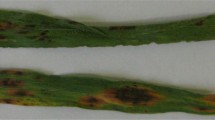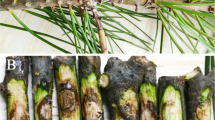Abstract
Pyricularia oryzae pathotype Triticum (PoT) causes wheat blast and is associated with other poaceous hosts. In addition, there are four pathogens of the genus Pyricularia found in or near wheat fields, P. oryzae patotype Lolium (PoL), P. grisea (Pg), P. pennisetigena (Pp), and P. urashimae (Pu). The pathogenicity and virulence levels of Pp and Pu on wheat heads are still unknown. The highest yield losses happen when blast pathogens infect wheat heads. In this study, 25 isolates of Pyricularia spp. were recovered from poaceous hosts invasive of commercial wheat fields previously treated with fungicides. Multilocus phylogenetic analyses (ACT-RPB1-CAL) was used for species delimitation. Nine isolates were identified as PoT, seven as Pp, three as Pg, three as PoL, and three as Pu. Isolates' ability to cause blast disease on the wheat head cv. Anahuac 75 was also evaluated. Wheat heads artificially inoculated with PoT, Pu and Pp showed higher severity values (8.84 to 17.60% of injured area) and differed significantly from Pg, which did not cause lesions on heads. Lesions caused by isolates of Pp and Pu were indistinguishable from those caused by PoT in the inoculation tests. We are reporting for the first time that Pp and Pu cause blast lesions on the head of adult wheat plants that are indistinguishable from those caused by PoT. Our findings show that multiple Pyricularia species can cause blast disease on heads of wheat adult plants under greenhouse conditions with indistinguishable symptoms.




Similar content being viewed by others
Data Availability
The sequencing data that supports the findings of this study are available in the GenBank/NCBI with accession numbers of DNA sequences described in Table 1 of this article while the disease severity data are available upon request.
References
Arruda, M. A., Bueno, C. R. N. C., Zamprogno, K. C., Lavorenti, N. A., & Urashima, A. S. (2005). Reação do trigo à Magnaporthe grisea nos diferentes estádios de desenvolvimento. Fitopatologia Brasileira, 30, 121–126. https://doi.org/10.1590/S0100-41582005000200003
Barragan, A. C., Latorre, S. M., Mock, P. G., Harant, A., Win, J., Malmgren, A., Burbano, H. A., Kamoun, S. & Langner, T. (2022). Wild grass isolates of Magnaporthe (Syn. Pyricularia) spp. from Germany can cause blast disease on cereal crops. bioRxiv, 505667. https://doi.org/10.1101/2022.08.29.505667
Callaway, E. (2016). Devastating wheat fungus appears in Asia for first time. Nature, 532, 421–422. https://doi.org/10.1038/532421a
Castroagudin, V. L., Moreira, S. I., Pereira, D. A. S., Moreira, S. S., Brunner, P. C., Maciel, J. L. N., Crous, P. W., McDonald, B. A., Alves, E. & Ceresini, P. C. (2016). Pyricularia graminis-tritici, a new Pyricularia species causing wheat blast. Persoonia - Molecular Phylogeny and Evolution of Fungi, 37, 199–216. https://doi.org/10.3767/003158516X692149
Castroagudín, V. L., Danelli, A. L. D., Moreira, S. I., Reges, J. T. A., Carvalho, G., Maciel, J. L. N., Bonato, A. L. V., Forcelini, C. A., Alves, E., McDonald, B. A., Croll, D. & Ceresini, P. C. (2017). The wheat blast pathogen Pyricularia graminis-tritici has complex origins and a disease cycle spanning multiple grass hosts. bioRxiv, 203455. https://doi.org/10.1101/203455
Ceresini, P. C., Castroagudin, V. L., Rodrigues, F. A., Rios, J. A., Aucique-Pérez, C. D., Moreira, S. I., Alves, E., Croll, C., & Maciel, J. L. N. (2018). Wheat Blast: Past, Present, and Future. Annual Review of Phytopathology, 56, 427–456. https://doi.org/10.1146/annurev-phyto-080417-050036
Coelho, M. A. O., Torres, G. A. M., Cecon, P. R., & Santana, F. M. (2016). Sowing date reduces the incidence of wheat blast disease. Pesquisa Agropecuária Brasileira, 51, 631–637. https://doi.org/10.1590/S0100-204X2016000500025
Crous, P. W., Wingfiel, M. J., Burgess, T. I., et al. (2016). Fungal Planet description sheets: 469–557. Persoonia - Molecular Phylogeny and Evolution of Fungi, 37, 368–369. https://doi.org/10.3767/003158516x694499
Cruz, C. D., & Valent, B. (2017). Wheat blast disease: Danger on the move. Tropical Plant Pathology, 42, 210–222. https://doi.org/10.1007/s40858-017-0159-z
Cruz, C. D., Bockus, W. W., Stack, J. P., Tang, X., Valent, B., Pedley, K. F., & Peterson, G. L. (2012). Preliminary assessment of resistance among U.S. wheat cultivars to the Triticum pathotype of Magnaporthe oryzae. Plant Diseases, 96, 1501–1505. https://doi.org/10.1094/pdis-11-11-0944-re
Cruz, C. D., Kiyuna, J., Bockus, W. W., Todd, T. C., Stack, J. P., & Valent, B. (2015). Magnaporthe oryzae conidia on basal wheat leaves as a potential source of wheat blast inoculum. Plant Pathology, 64, 1491–1498. https://doi.org/10.1111/ppa.12414
Dorigan, A. F., Carvalho, G., Poloni, N. M., Negrisoli, M. M., Maciel, J., & Ceresini, P. C. (2019). Resistance to triazole fungicides in Pyricularia species is associated with invasive plants from wheat fields in Brazil. Acta Scientiarum Agronomy, 41, 1–10. https://doi.org/10.4025/actasciagron.v41i1.39332
Farman, M. (2002). Pyricularia grisea isolates causing gray leaf spot on Perennial Ryegrass (Lolium perenne) in the United States: Relationship to P. grisea Isolates from other host plants. Phytopathology, 92, 245–254. https://doi.org/10.1094/phyto.2002.92.3.245
Farman, M., Peterson, G., Chen, L., Starnes, J., Valent, B., Bachi, P., Murdock, L., Hershman, D., Pedley, K., Fernandes, J. M., & Bavaresco, J. (2017). The Lolium pathotype of Magnaporthe oryzae recovered from a single blasted wheat plant in the United States. Plant Diseases, 101, 684–692. https://doi.org/10.1094/PDIS-05-16-0700-RE
Ferreira, E. B., & Cavalcanti, P. P. (2009). Função em código R para analisar experimentos em DIC simples, em uma só rodada. Reunião anual da região brasileira da sociedade internacional de biometria, 54º Simpósio de estatística aplicada a experimentação agronômica. São Paulo, SP: UFSCar, 13, 1–5.
Gladieux, P., Condon, B., Ravel, S., Soanes, D., Maciel, J., & Nhani, A. J. (2018). Gene flow between divergent cereal- and grass-specific lineages of the rice blast fungus Magnaporthe oryzae. Mbio, 9, e01219–e01317. https://doi.org/10.1128/mBio.01219-17
Goulart, A. (2005). Perdas em trigo causadas pela brusone. In: Workshop de Epidemiologia de Doenças de Plantas. Viçosa, MG. Quantificação de perdas no manejo de doenças de plantas: anais (pp. 123–130). Viçosa, MG: Universidade Federal de Viçosa, 2004b.
Government of India. (2016). Minutes of the meeting on “Occurrence of blast disease on wheat” held under the Chairmanship of Agriculture Commissioner on 28th September, 2016 at Kolkata. File 4–2/20 13-NFSM., Minist. Agric. & Farmers Welf, Dep. Agric. Coop. & Farmers Welf., Crops Div. NFSM Cell. Krishi Bhawan, New Delhi, India
Hepperle, D. (2004). SeqAssem©. Win32-Version. A sequence analysis tool contig assembler and trace data visualization tool for molecular sequences. Retrieved Jan 21, 2023, from: http://www.sequentix.de/
Igarashi, S. (1986). Ocorrência de Pyricularia spp. no estado do Paraná. Fitopatologia Brasileira, 11, 351–352.
Islam, M. T., Croll, D., Gladieux, P., Soanes, D. M., Persoons, & Kamoun, S. (2016). Emergence of wheat blast in Bangladesh was caused by a South American lineage of Magnaporthe oryzae. BMC Biology, 14, 84. https://bmcbiol.biomedcentral.com/articles/10.1186/s12915-016-0309-7
Klaubauf, S., Tharreau, D., Fournier, E., Groenewald, J. Z., Crous, P. W., de Vries, R. P., & Lebrun, M. H. (2014). Resolving the polyphyletic nature of Pyricularia (Pyriculariaceae). Studies in Mycology, 79, 85–120. https://doi.org/10.1016/j.simyco.2014.09.004
Kohli, M. M., Mehta, Y. R., Guzman, E., Viedma, L. D. E., & Cubilla, L. E. (2011). Pyricularia Blast – a Threat to Wheat Cultivation. Czech Journal of Genetics and Plant Breeding, 47, 130–134. https://doi.org/10.17221/3267-CJGPB
Kumar, S., Stecher, G., Li, M., Knyaz, C., & Tamura, K. (2018). MEGA X: Molecular evolutionary genetics analysis across computing platforms. Molecular Biology and Evolution, 35, 1547–1549. https://doi.org/10.1093/molbev/msy096
Martínez, S. I., Sanabria, A., Fleitas, M. C., Consolo, V. F., & Perelló, A. (2019). Wheat blast: Aggressiveness of isolates of Pyricularia oryzae and effect on grain quality. Journal of King Saud University - Science, 31, 150–157. https://doi.org/10.1016/j.jksus.2018.05.003
Mehta, Y. R. (2014). Pillars of integrated disease management. In Wheat Diseases and Their Management, 17–63. https://doi.org/10.1007/978-3-319-06465-9_2
Oh, H. S., Tosa, Y., Takabayashi, N., Nakagawa, S., Tomita, R., Don, L. D., Kusaba, M., Nakayashiki, H., & Mayama, S. (2002). Characterization of an Avena isolate of Magnaporthe grisea and identification of a locus conditioning its specificity on oat. Canadian Journal of Botany, 80, 1088–1095. https://doi.org/10.1139/b02-101
Plantwise. (2016). Wheat blast Pest Management Decision Guide: Green List. Surrey, UK: CABI. http://www.plantwise.org/FullTextPDF/2016/20167800929.pdf. 8th November, 2017.
Rahnama, M., Phillips, T. D., & Farman, M. (2020). First Report of the Blast Pathogen, Pyricularia oryzae,on Eragrostis tef in the United States. Plant Diseases, 104. https://doi.org/10.1094/PDIS-02-20-0255-PDN
Reges, J. T. A., Negrisoli, M. M., Dorigan, A. F., Castroagudin, V. L., Maciel, J. L. N., & Ceresini, P. C. (2016). Pyricularia pennisetigena and P. zingibericola from invasive grasses infect signal grass, barley and wheat. Pesquisa Agropecuária Tropical, 46, 206–214. https://doi.org/10.1590/1983-40632016v4641335
Sadat, M. A., & Choi, J. (2017). Wheat blast: a new fungal inhabitant to Bangladesh threatening world wheat production. The Plant Pathology Journal, 33, 103–8. https://doi.org/10.5423/PPJ.RW.09.2016.0179
Santos, H. P., Lhamby, J. C. B., Prestes, A. M., & de Lima, M. R. (2000). Efeito de manejos de solo e de rotação de culturas de inverno no rendimento e doenças de trigo. Pesquisa Agropecuária Brasileira, 35, 2355–2361. https://doi.org/10.1590/S0100-204X2000001200005
Sousa, P. G. (1999). 25 anos de melhoramento genético de trigo em Mato Grosso do Sul. Dourados: Embrapa Agropecuária Oeste, 1–27.
Stevenson, K. L., McGrath, M. T., & Wyenandt, C. A. (2018). Fungicide Resistance in North America. Book, 2, 51–68. https://doi.org/10.1094/9780890546222
Stukenbrock, E. H., & McDonald, B. A. (2008). The origins of plant pathogens in agro-ecosystems. Annual Review of Phytopathology, 46, 75–100. https://doi.org/10.1146/annurev.phyto.010708.154114
Tembo, B., Mulenga, R. M., Sichilima, S., M’siska, K. K., Mwale, M., Chikoti, P. C., Singh, P. K., He, X., Pedley, K. F., Peterson, G. L., Singh, R. P., & Braun, H. J. (2020). Detection and Characterization of Fungus (Magnaporthe Oryzae Pathotype Triticum) Causing Wheat Blast Disease on Rain-Fed Grown Wheat (Triticum Aestivum L) in Zambia. PLoS ONE, 15, e0238724. https://doi.org/10.1371/journal.pone.0238724
Tosa, Y., Hirata, K., Tamba, H., Nakagawa, S., Chuma, I., Isobe, C., Osue, J., Urashima, A. S., Don, L. D., Kusaba, M., Nakayashiki, H., Tanaka, A., Tani, T., Mori, N., & Mayama, S. (2004). Genetic constitution and pathogenicity of Lolium isolates of Magnaporthe oryzae in comparison with host species-specific pathotypes of the blast fungus. Phytopathology, 94, 454–462. https://doi.org/10.1094/PHYTO.2004.94.5.454
Urashima, A. S., & Kato, H. (1994). Varietal resistance and chemical control of wheat blast fungus. Summa Phytopathologica, 20, 107–112.
Urashima, A. S., Igarashi, S., & Kato, H. (1993). Host range, mating type, and fertility of Pyricularia grisea from wheat in Brazil. Plant Diseases, 77, 1211–1216. https://doi.org/10.1094/PD-77-1211
Urashima, A. S., Grosso, C. R. F., Stabili, A., Freitas, E. G., Silva, C. P., Netto, D. C. S., Franco, I. & Merola Bottan, J. H. (2009). Effect of Magnaporthe grisea on seed germination, yield and quality of wheat. Advances in Genetics, Genomics and Control of Rice Blast Disease, 267–277. https://doi.org/10.1007/978-1-4020-9500-9_27
Zadocks, J. C., Chang, T. T., & Konzak, C. F. (1974). A decimal code for the growth stages of cereals. Weed Research, 14, 415–421.
Acknowledgements
This study was funded by the São Paulo Research Foundation, Brazil, which supports Ceresini P.C. (Fapesp 2018 /21197-0). Dorigan A.F. was supported by a PhD fellowship from CAPES (Coordination for the improvement of higher education personnel, Brazil). FAPEMIG (Research Support Foundation of the State of Minas Gerais) supports Alves E. (Fapemig CAG-APQ01975-15). Alves E. is supported by a productivity grant from the National Council for Scientific and Technological Development (CNPq 305482/2017-3).
Author information
Authors and Affiliations
Corresponding author
Ethics declarations
Conflict of interest
The authors declare that they have no conflict of interest.
Research involving human participants and/or animals
This study does not include experiments with either human participants or animals.
Rights and permissions
Springer Nature or its licensor (e.g. a society or other partner) holds exclusive rights to this article under a publishing agreement with the author(s) or other rightsholder(s); author self-archiving of the accepted manuscript version of this article is solely governed by the terms of such publishing agreement and applicable law.
About this article
Cite this article
Dorigan, A.F., da Silva Costa Guimarães, S., Vicentini, S.N.C. et al. Pyricularia pennisetigena and Pyricularia urashimae can also cause wheat head blast. Eur J Plant Pathol 167, 157–168 (2023). https://doi.org/10.1007/s10658-023-02690-3
Accepted:
Published:
Issue Date:
DOI: https://doi.org/10.1007/s10658-023-02690-3




